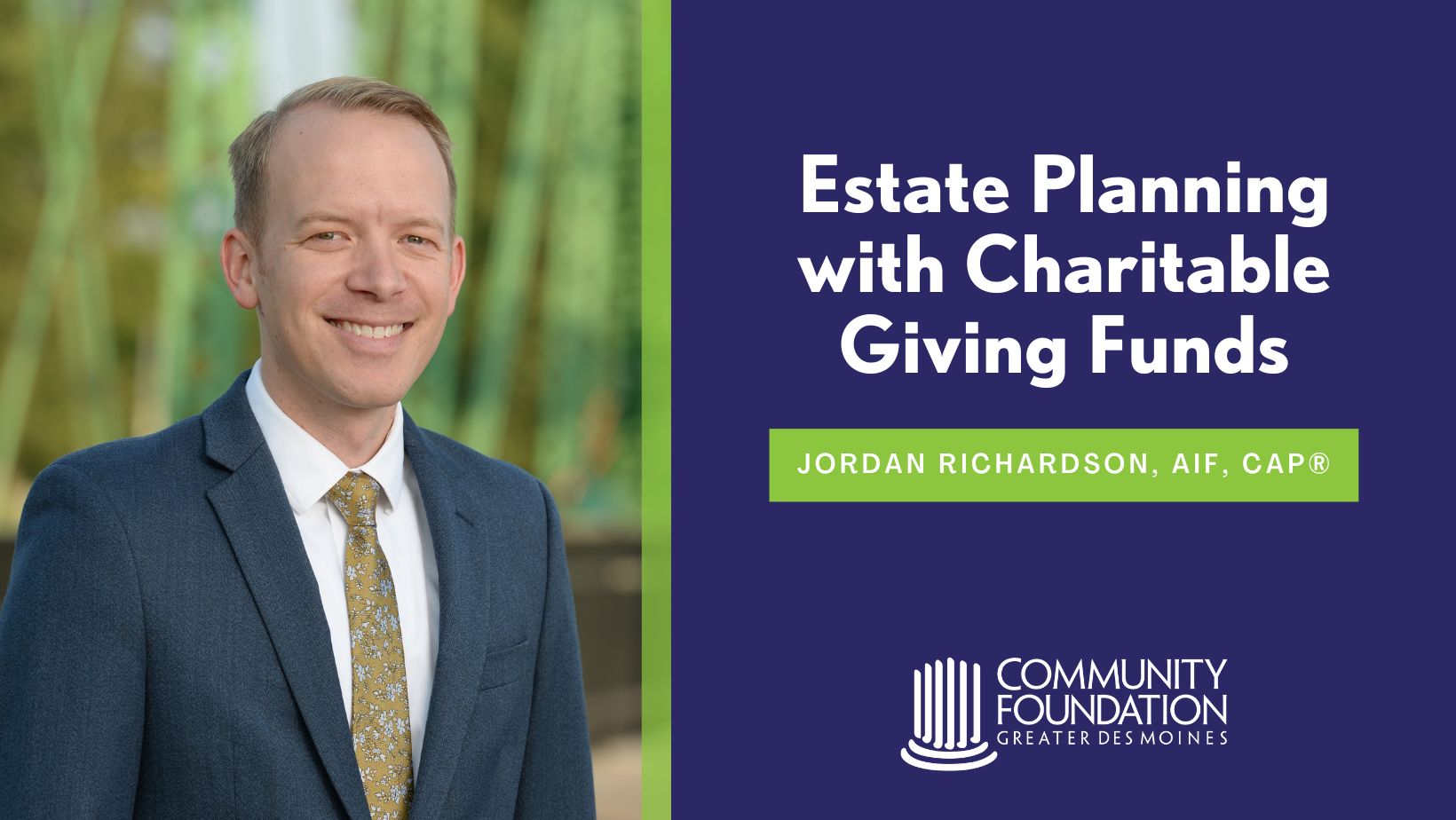Estate Planning with Charitable Giving Funds
Nov. 1, 2022

By Jordan Richardson, AIF, CAP®, Senior Charitable Giving Advisor
Over $46 billion was given to charity by bequest in 2021, according to Giving USA’s annual study. Put another way, nearly 10 percent of all charitable giving ($484.85 billion) occurred through estate plans.
It is likely not a surprise to any of us that charity plays a role in the estate. For a few, it offers shelter against the estate tax. But for many individuals, the bequest provides an opportunity to leave a legacy with the organizations that best align with their values and passions.
In its simplest form, an individual might choose to name a specific charity to receive a residual benefit from his or her will. Your firm probably has templated language to address this. In fact, many nonprofits do, too.
While that strategy works well in simple cases, simplicity is increasingly rare. For example, your client might feel anxious about selecting a specific list of charities today. And even if they feel confident about their list today, a future experience or programmatic change at an organization might result in a change of heart. Your clients may also desire more flexibility and fluidity in the timing of their gifts, rather than giving the charity a significant single contribution at their deaths.
These potential barriers can be addressed effectively by engaging a charitable giving fund. Charitable giving funds, such as donor advised funds (DAFs), provide a simple, powerful and personal approach to giving. For individuals who give charitably during their lifetimes, a donor advised fund can provide significant value by streamlining giving over time in an efficient, organized and tax-wise manner now and in the future.
For clients with an existing DAF (or clients who might be interested in establishing one), the DAF has the potential to act as an effective charitable complement to their will or trust. This is because most DAFs include a succession plan. Those plans range from appointing heirs to oversee future charitable giving decisions, to naming specific charities or areas of interest to receive a one-time gift or a stream of future distributions.
Take Client A for example. Client A gives regularly to several charities and has established a DAF to streamline charitable giving during his lifetime. When updating his will, Client A tells his attorney he would like to set aside the residual of his estate to benefit two charities equally. While he could name those two charities directly in his will, his attorney suggests he bequeath the residual of his estate to the DAF instead. The result is the same, as the two charities are now in line to receive a distribution from Client A, but Client A has now given himself the flexibility to amend his charitable plans in the future without requiring the will to be revised.
Five years later, Client A begins serving as a board member for a third charity and feels drawn to adding this additional organization to his charitable estate plan. Thanks to the foresight of his attorney five years prior, Client A simply reaches out to his DAF administrator and updates his succession plan to include the third charity. No update to the will is necessary. Easy!
But what if your client does not have an existing DAF and does not have a current giving plan that justifies establishing one? Could they establish a testamentary DAF? Possibly!
At the Community Foundation of Greater Des Moines, we call this a legacy fund, and it provides for significant flexibility and peace of mind in planning for future charitable giving.
Let’s consider Client B. Similar to Client A, Client B would like to leave a sizable portion of her estate to charity. Unlike Client A, however, Client B does not currently utilize a donor-advised fund and is not interested in doing so. Client B and her attorney have determined 50 percent of her estate should go to charity, but she is challenged to develop a specific list of charities. Client B’s giving changes periodically as new opportunities arise that align with her goals and values.
Rather than losing sleep over developing a list of charitable beneficiaries, Client B and her attorney opt to instead create a legacy fund – the “Client B Family Legacy Fund.” The will is drafted to give 50 percent of the estate to the legacy fund at the local community foundation. Client B meets with community foundation staff to develop her charitable instructions. Subsequent meetings with the community foundation result in a few adjustments to the plan, but much like Client A, Client B is never required to revise her will to make those changes.
At Client B’s death, 50 percent of her estate flows to the Client B Family Legacy Fund at the community foundation and the predetermined charitable instructions are executed. In Client B’s case, several charities receive an immediate distribution, while the remainder of the charitable balance lives on as a donor-advised fund, with Client B’s children overseeing future distributions.
While Clients A and B are fictional cases, I have had the opportunity to connect with many individuals in similar scenarios. Planning for our legacy can be challenging – especially when it involves trusting organizations to steward our financial resources after we are gone. Charitable giving funds like these can be powerful tools to provide peace of mind with efficiency and flexibility, while giving clients opportunities to tangibly share their charitable hopes and dreams.